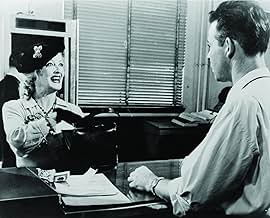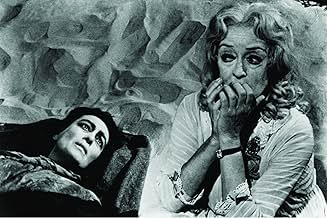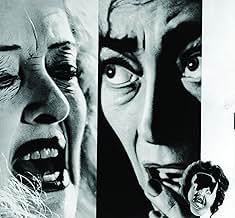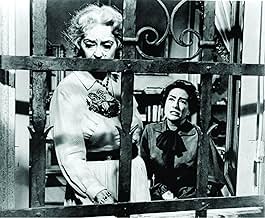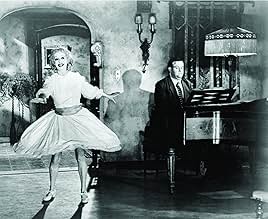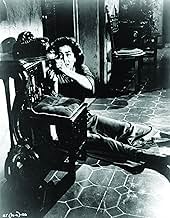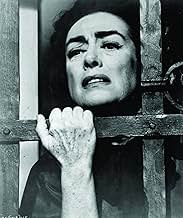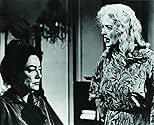Uma ex-estrela infantil atormenta sua irmã paraplégica em sua decadente mansão em Hollywood.Uma ex-estrela infantil atormenta sua irmã paraplégica em sua decadente mansão em Hollywood.Uma ex-estrela infantil atormenta sua irmã paraplégica em sua decadente mansão em Hollywood.
- Direção
- Roteiristas
- Artistas
- Ganhou 1 Oscar
- 5 vitórias e 11 indicações no total
- Cora Hudson
- (as Ann Barton)
- Liza Bates
- (as B.D. Merrill)
- Direção
- Roteiristas
- Elenco e equipe completos
- Produção, bilheteria e muito mais no IMDbPro
Avaliações em destaque
The story focuses on two sisters, Blanche Hudson (Joan Crawford) who was crippled in an accident awhile ago and "Baby" Jane Hudson (Bette Davis). Jane used to be a big child star, she even had a doll brand after her. Now, though, she is no longer recognised while her sister has recently become very famous. They live in an old mansion, with Blanche confined to her room upstairs while Jane gets madder and more cruel by the day.
Bette Davis gives the star performance here, some may call it over-acting but it is far from. She really makes Jane as mad, cruel and sad as possible. Joan Crawford is equally good in a very different role. She is much more timid then Jane and quite scared. The supporting cast are all good as well, especially Victor Buono as Victor Flagg, an odd pianist that befriends Jane. The black and white really are used to full effect, they make the mansion look extra creepy. Robert Aldrich's direction is fine.
To today's modern audience, this may seem boring as it does not have any action. Most of the movie is dialogue, but I do urge those who haven't seen it to do so, as it is a truly excellent movie.
A solid 5/5!
A touch of Norma Desmond/Sunset Boulevard here--Bette as a delusional has-been who actually believes her career can be resurrected. Joan as the sister confined to a wheelchair as a result of a horrific car accident. In the drive-way. Supposedly run over by Baby Jane in the 1930s but never proven or prosecuted.
Fast forward to the 1960s, and Baby Jane takes it hard upon learning Blanche plans to sell their old stately mansion. She begins a systematic torture of Blanche that amounts to elder abuse in today's terms. Viewers who saw this film 60 years ago were frightened by the hair-raising dinner entrees given to Blanche: Her dead pet bird served up on a tray of tomatoes and the rat well-done. What doesn't hold up is Blanche's inability to bring attention to her imprisonment. For instance, her neighbor is outside below her window cutting flowers. Instead of screaming like a maniac for help, she writes a complicated note on a typewriter, balls it up, and throws it out the window. Of course, Baby Jane finds it. Duh. When the affected Victor Buono visits the house as a loony piano accompanist for Blanche, she could have screamed and yelled for help. She doesn't.
For all their competition, both Bette and Joan are good here and the ending is extremely ironic. Davis always claimed that Joan campaigned against her at Oscar time and that is why she didn't win. Davis certainly hadn't lost her willingness to look as unattractive as she needed to be in order to play the part. Overweight, dressed up like she is 10 not 55 with her hair in blonde curls and grotesque pancake makeup on, she is the ideal aged homicidal maniac of a Baby Jane doll. Joan's part requires much more subtlety to the point of not doing what she must to save herself. These two definitely make it a worthwhile watch.
Você sabia?
- CuriosidadesAccording to Bette Davis in her book "This N' That," the film was originally going to be shot in color. Davis opposed this, saying that it would just make a sad story look pretty.
- Erros de gravaçãoIn the 1935 time line (11 minutes into the film), Ben Golden (Bert Freed) and Marty McDonald (Wesley Addy) are walking past a row of buildings in the studio discussing Baby Jane's acting. There are window air conditioners in almost every upper floor window of the 2-story building behind them. But the first window air conditioner wasn't marketed until 1938, and it wasn't until 1947 that they were mass-produced.
- Citações
Blanche: Jane, do you remember when I first came back after the accident?
Jane: You promised you wouldn't ever talk about that again.
Blanche: I know I did. But I'm still in this chair. After all those years, I'm still in this chair. Doesn't that give you some kind of responsibility? Jane, I'm just trying to explain to you how things really are. You wouldn't be able to do these awful things to me if I weren't still in this chair.
Jane: But you *are*, Blanche! You *are* in that chair!
- Versões alternativasThe original British release was cut in two places: in Reel Four, where Jane kicks Blanche only once instead of multiple times, and Reel Six, which eliminated some shots of Blanche tied up to the bed and writhing. Both cuts were mandated by the BBFC in order to receive an "X" certificate. Subsequent reissues restored the footage.
- ConexõesEdited into The Time That Remains (2012)
- Trilhas sonorasI've Written a Letter to Daddy
Music by Frank De Vol
Lyrics by Bob Merrill
Performed by Bette Davis
Also performed by Julie Allred (dubbed by Debbie Burton)
Principais escolhas
- How long is What Ever Happened to Baby Jane??Fornecido pela Alexa
- What is 'Whatever Happened to Baby Jane?' about?
- Is 'Whatever Happened to Baby Jane?' based on a book?
- How does the movie end?
Detalhes
- Data de lançamento
- País de origem
- Central de atendimento oficial
- Idioma
- Também conhecido como
- O que Aconteceu com Baby Jane?
- Locações de filme
- Empresa de produção
- Consulte mais créditos da empresa na IMDbPro
Bilheteria
- Orçamento
- US$ 980.000 (estimativa)
- Faturamento bruto mundial
- US$ 4.451
- Tempo de duração2 horas 14 minutos
- Cor
- Proporção
- 1.85 : 1
Contribua para esta página





